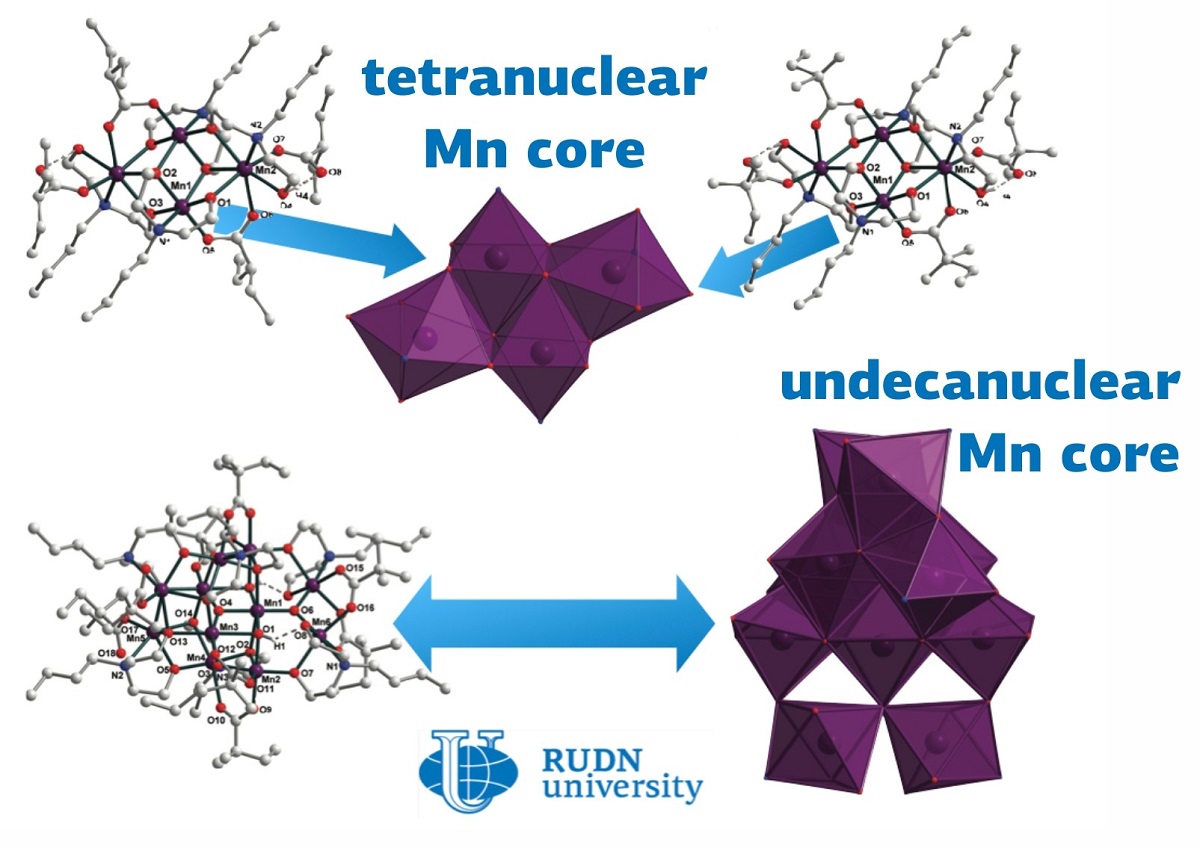RUDN Chemists discovered three complex compounds with rare magnetic properties

Coordination complex is complex structure with a metal atom in the center, to which various ligand molecules are attached. If there are more than two of these atoms, the compounds are referred to as multinuclear. In this case, the metal framework can look like chains, branched cycles, polyhedra or their combinations. Non-standard bonds between metals allow obtaining compounds with unusual metal oxidation states and pronounced catalytic properties. This allows their application in the synthesis of drugs, varnishes, and paints, as well as in other branches of the chemical industry. In addition, the magnetic properties of such complexes can be used for new ways to store information. Manganese also forms complex compounds, for example, inside chlorophyll, through which photosynthesis occurs. However, multinuclear complexes with manganese are often unstable. RUDN chemists reported the synthesis of several compounds of this class at once.
"In this paper, we describe the synthesis methods, crystal structure, and magnetic properties of three new multinuclear mixed valence clusters that we were able to obtain from manganese (II) chloride," co-author Dmitro Nesterov from RUDN.
The valence is indicated by Roman numerals and shows the ability to form a certain number of chemical bonds. Two of the described compounds are tetranuclear and contain two manganese atoms each with valence II and two each with valence III. In [MnII2MnIII2(HBuDea)2 2(BuDea)2(EBA)4] the ligands were 2-ethyl ether of butyric acid and N-butyl diethanolamine, and in the second compound [MnII2MnIII2(HBuDea) 2(BuDea)2(DMBA)4] - N-butyl diethanolamine and 2,2-dimethyl ether of butyric acid. In the third compound, three manganese II atoms, eight manganese III atoms, and four oxygen atoms form an eleven-nuclear structure to which the ligands N-butyldietanolamine and 2,2-dimethyl ester of butyric acid are attached.
RUDN chemist and his colleagues from Slovakia and Portugal succeeded in obtaining these complexes using self-assembly reactions. The synthesis requires manganese (II) chloride, a solution of carbolic acid in methanol, and 2-ethyl ester of butyric acid for the first compound, and 2,2-dimethyl ester of butyric acid for the second and third. Whether the second route produced a four-nuclear or an eleven-nuclear cluster depended on the experimental conditions. X-ray crystallography showed that both quadruple nuclei had a similar symmetrical structure, while the third had a non-standard structure. The quaternary complexes exhibited the properties of a single-molecule magnet - that is, they can form superparamagnetic materials. This means that they can be uniformly magnetized throughout their volume and change their magnetic moment depending on temperature. The eleven-nucleus cluster, on the contrary, had antiferromagnetic properties, i.e., the magnetic moments of the particles in such a substance are in pairs directed in opposite directions.
"Also in the paper we discussed the possible influence of intramolecular effects and the different surroundings of the magnetic nuclei that the 2-ethyl ester of butyric acid and 2,2-dimethyl ester of butyric acid ligands formed. Superparamagnetics and antiferromagnetics exhibit unusual properties that could be used in future high-tech applications. For example, they can become the basis for new generation memory cells, where only a few tens of atoms are required to record information," Nesterov added.
The results of the study were published in Dalton Transactions.
The project to develop a cellular model of the placenta became the winner in the Scientific Materials category of the Young Scientists 3.0 competition, organized with the support of the Presidential Grants Foundation and T-Bank.
Ten scientific journals published by RUDN University have been included in the highest level of the state list of scientific publications, the White List.
Forests are not only the lungs of the planet, but also home to millions of species. However, it has remained unclear how underground interactions between trees and fungi affect forest species richness in different climatic conditions. Previous studies have yielded conflicting results: in some regions, the dominance of certain fungi reduced tree diversity, while in others it increased it.
The project to develop a cellular model of the placenta became the winner in the Scientific Materials category of the Young Scientists 3.0 competition, organized with the support of the Presidential Grants Foundation and T-Bank.
Ten scientific journals published by RUDN University have been included in the highest level of the state list of scientific publications, the White List.
Forests are not only the lungs of the planet, but also home to millions of species. However, it has remained unclear how underground interactions between trees and fungi affect forest species richness in different climatic conditions. Previous studies have yielded conflicting results: in some regions, the dominance of certain fungi reduced tree diversity, while in others it increased it.